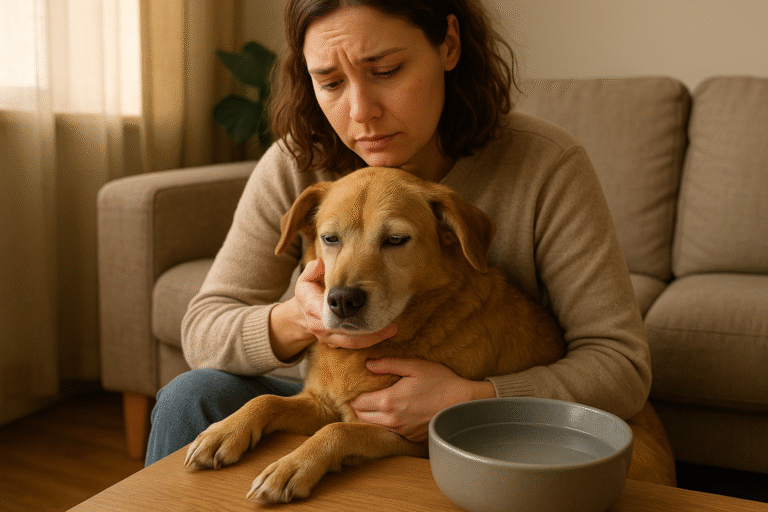Discover the top 10 common household pet poisons that may be hiding in plain sight. Learn about the pet poisoning dangers and how to keep your furry friends safe at home.
Table of Contents
ToggleIntroduction
For most loving pet parents, home feels like the safest place to raise their furry family members. Yet, lurking in many kitchens, bathrooms, and living rooms are items that pose significant pet poisoning dangers. From delicious foods like chocolate to invisible threats like xylitol, there are numerous common household pet poisons that can endanger your dog or cat’s health—often without warning.
Although these substances might appear ordinary to humans, they can lead to fatal consequences for pets. With more awareness and a proactive approach, these dangers can be minimized significantly. The following guide highlights the most threatening items and explains how to recognize poisoning signs early.
Key Facts
- Over 232,000 pet poisoning incidents are reported annually to the ASPCA Animal Poison Control Center.
- Most common poisoning cases involve food, household chemicals, or plants.
- Dogs and cats can suffer severe reactions even from small quantities of toxic substances.
- Early intervention is crucial and often life-saving.
1. Xylitol (Artificial Sweetener)
One of the most overlooked but common household pet poisons is xylitol. Found in sugar-free gums, candies, baked goods, and even some peanut butter brands, this sweetener is safe for humans but toxic to dogs. It triggers insulin release, which causes blood sugar to drop dangerously low. In advanced cases, it can result in liver failure.
Symptoms of Xylitol Poisoning:
- Sudden vomiting
- Weakness or lethargy
- Loss of coordination
- Seizures
- Collapse
Prevention Tips:
- Keep all sugar-free products out of reach.
- Avoid using xylitol-based peanut butter in treats.
- Always read ingredient labels when giving human food to pets.
Safe Alternatives:
- Use xylitol-free peanut butter for dogs.
- Opt for pet-safe chew toys instead of flavored dental sticks.
What to Do: Immediate veterinary intervention is essential. Do not attempt to induce vomiting unless specifically instructed by a veterinarian.
2. Chocolate
Chocolate remains one of the most reported pet poisoning dangers. The culprit is theobromine, a compound that pets process very slowly. Dark chocolate, baking chocolate, and cocoa powder contain the highest theobromine levels and are the most dangerous.
Symptoms of Chocolate Poisoning:
- Hyperactivity and restlessness
- Vomiting and diarrhea
- Elevated heart rate
- Muscle tremors
Real-Life Case:
A Labrador that consumed a tray of brownies began vomiting and had seizures within two hours. Emergency care stabilized the pet.
Safe Practices:
- Never leave chocolate unattended.
- Inform children not to share chocolate with pets.
- Store sweets in closed cabinets.
What to Do: Seek emergency care and provide the vet with details on the chocolate type and quantity consumed.
3. Garlic and Onions
Both garlic and onions contain thiosulfate, a substance that damages red blood cells in cats and dogs. Regular ingestion can lead to anemia, one of the more silent but deadly pet poisoning dangers.
Common Sources:
- Leftover table scraps
- Seasoned meat and gravies
- Baby foods
Symptoms:
- Weakness
- Pale gums
- Vomiting
- Increased heart rate
Prevention:
- Avoid feeding pets leftovers with seasoning.
- Read baby food labels if offering them to sick pets.
What to Do: Call your veterinarian for bloodwork to assess red blood cell damage.
4. Household Cleaning Products
Many cleaning agents like bleach, ammonia, and toilet bowl tablets fall under the category of common household pet poisons. Pets may walk over freshly cleaned floors and later lick their paws, unknowingly ingesting toxins.
Symptoms:
- Drooling
- Chemical burns
- Vomiting
- Breathing difficulties
Prevention:
- Use pet-safe cleaning brands.
- Ensure surfaces are fully dry before allowing pets back.
Safe Alternatives:
- Vinegar and water
- Baking soda-based cleaners
What to Do: Rinse any exposed area with cool water and contact a vet.
5. Grapes and Raisins
Even though grapes and raisins are healthy for humans, they can cause kidney failure in dogs. The toxic compound is still unknown, making them particularly risky.
Symptoms:
- Vomiting within hours
- Lethargy
- Abdominal discomfort
- Little or no urination
Prevention:
- Avoid sharing trail mix or cereals.
- Store dried fruits securely.
What to Do: Do not wait for symptoms. Contact your vet immediately for potential decontamination.
6. Human Medications
Painkillers like ibuprofen, cold medicines, and antidepressants are among the leading causes of pet poisoning. Even a single pill can lead to severe reactions.
Symptoms:
- Vomiting
- Stomach ulcers
- Kidney or liver damage
- Disorientation
Prevention:
- Store all medication in secure cabinets.
- Never leave pills on counters or bedside tables.
What to Do: Never administer any human medicine to pets. Take the medication bottle with you to the vet.
7. Rodenticides (Rat and Mouse Poisons)
These poisons are formulated to attract rodents but are equally appealing to pets. Rodenticides cause internal bleeding or seizures, depending on the active compound.
Symptoms:
- Weakness
- Bleeding from nose or gums
- Bruising
- Neurological changes
Prevention:
- Use pet-safe traps instead of poison.
- Place poison baits where pets can’t reach—ideally outside your home.
What to Do: Time is critical. Bring packaging to the vet to determine the right antidote.
8. Alcohol and Caffeine
Both substances depress the central nervous system and can cause rapid health deterioration in pets. Ingestion often occurs from alcoholic spills or chewing on coffee grounds and tea bags.
Symptoms:
- Vomiting
- Hyperactivity
- Collapse
- Seizures
Prevention:
- Clean up spilled drinks promptly.
- Avoid using caffeine-based supplements near pets.
What to Do: Seek immediate veterinary assistance. Do not wait for symptoms to worsen.
9. Certain Houseplants
Beautiful as they may be, many common houseplants are toxic to cats and dogs. Lilies, in particular, are extremely toxic to cats and can cause kidney failure.
Toxic Plants:
- Lilies
- Aloe vera
- Sago palm
- Philodendrons
Symptoms:
- Vomiting
- Drooling
- Lethargy
- Difficulty breathing
Pet-Safe Alternatives:
- Spider plant
- Areca palm
- Prayer plant
What to Do: Identify the plant and contact your vet or poison control. Early treatment can prevent organ damage.
10. Essential Oils and Diffusers
Essential oils are increasingly popular in households, but many are toxic to pets when ingested or inhaled. Cats are particularly sensitive due to their liver metabolism.
Harmful Oils Include:
- Tea tree
- Eucalyptus
- Citrus
- Peppermint
Symptoms:
- Drooling
- Vomiting
- Muscle tremors
- Difficulty breathing
What to Do: Ventilate the area and remove the pet from exposure. Consult a vet if symptoms arise.
Preventive Measures
Avoiding pet poisoning dangers begins with prevention:
- Keep items out of reach – Store chemicals and food securely.
- Know what’s toxic – Keep a list of common poisons.
- Use pet-safe alternatives – Choose cleaners and plants wisely.
- Regular vet checkups – Help in early detection of issues.
- Immediate action matters – If poisoning is suspected, call the vet.
Conclusion
The presence of common household pet poisons should not be underestimated. Pet poisoning dangers lurk in everyday items from your kitchen to your living room. However, through awareness and precaution, most poisoning incidents can be prevented.
Let this guide serve as your action plan toward a toxin-free environment. Your pet depends on your vigilance to stay safe, healthy, and happy. After all, their well-being starts with what you allow into their surroundings.
Recent Posts









Related Topics
Copyright © 2025 The Pet Blog – Expert Tips, Care Guides & Fun Facts for Every Pet Lover.

